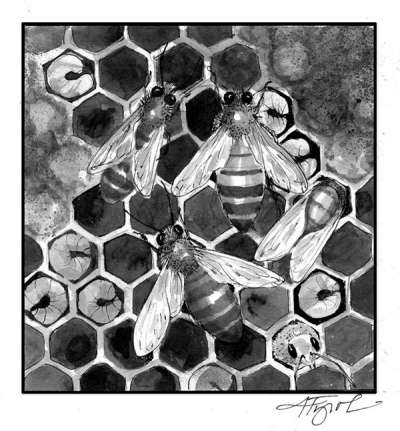
For some, spring begins with the flow of maple sap, or maybe the arrival of robins or redwing blackbirds. For inveterate gardeners the new season never really starts until the soil can be turned.
The arrival of honeybees in fields and orchards is an obvious sign of spring, and for the past several weeks honeybees have been moving about in their hives preparing to head out for the flowers.
In fact, things began picking up in honeybee hives long before the snow started melting. In some colonies the queen begins laying eggs as early as mid-winter. As larvae hatch, worker bees must get moving to feed them.
A colony of honeybees soon becomes crowded and busy. It might include tens of thousands of workers (unfertilized females), several hundred drones (males) but only one queen (fertile female). Each class of bees has a task: the drones mate with queens; the queens lay eggs, and the workers build and maintain the hive. As spring advances, the workers also collect food to feed the queen and the young bees.
Most species of social insects—including hornets, paper wasps, bumblebees and yellow jackets—have near-complete die-offs as winter approaches. With the exception of a colony’s queen, who hibernates in a rotting log or other protected area, all members of these species succumb in fall. In early spring, their queen emerges from hibernation and begins laying eggs to rebuild the colony.
Honeybees are different. Their workers spend spring, summer and fall storing food, so the queen and the workers can survive all winter. The drones that mate with the queen immediately expire. The remaining drones are tolerated and cared for in the hive until fall, when they’re escorted from the hives and left to die. Their departure can assure that the workers and queen have enough food in the hive for winter.
There are other forms of helpful population controls.
By fall the queen begins laying fewer eggs at a time and the older bees begin to die off. That means that a summertime colony population of up to 60,000 might drop to 10,000 by winter.
As winter approaches and temperatures drop, honeybees bunch together in their hives to conserve heat. The bees in the outer layer of the cluster compress tightly into a shell, which helps insulate those inside. The bees inside the cluster then use their wing muscles to shiver, causing an increased metabolic rate that releases heat for the whole cluster. Winter temperature on the outside edge of the cluster may hover around 40 degrees F., while the inner layer warms to 75 degrees.
In a warm cluster the queen can move about, laying the eggs that will become the spring foragers. The workers are busy, too, shifting their positions to cover new areas of the honeycomb to find food. The honeybees require some help from the weather: They need above-freezing days, so they can go outside to void excrement. They also need warm breaks, because a prolonged spell of extreme cold can inhibit cluster movement and cause starvation—even though the bees are only inches from a meal.
What’s on the honeybee menu? Nectar and pollen. Nectar, the sweet liquid from plants, is stored as honey after undergoing evaporation and the action of enzymes introduced by the bees. Nectar and pollen are collected well into fall—until the last goldenrod and asters succumb to frost.
The work of wild bees has been a source of sweetness and plant pollination for humans for centuries. Cave paintings in Egypt indicate that people were harvesting honey 8,000 years ago from wild hives. Although today most honeybees come from man-made hives, swarms of these bees occasionally escape into the wild to begin homesteading inside a hollow tree or similar shelter.
Sometime next month the honeybees of New Hampshire and Vermont will begin leaving their hives to find food. Temperature will be key: the mercury must reach 45 or 50 degrees F. for honeybees’ flight muscles to operate. Few if any wildflowers or garden flowers will be in blossom when the bees take flight; but they will find food in other places—early-flowering shrubs or trees, such as poplar, willow, alder or beaked hazelnut.
By late April honeybees will be buzzing among dandelions, chickweed, coltsfoot and mustard.

